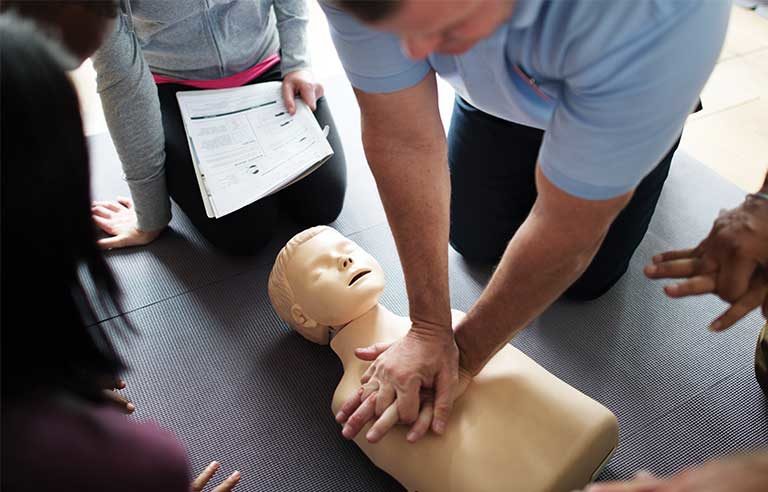You can help save a life
Learn – and train workers on – how to perform CPR and use an AED

The image of 24-year-old professional football player Damar Hamlin receiving CPR on the field during a nationally televised game is etched into the minds of people across the country.
When Hamlin, a player for the Buffalo Bills, went into cardiac arrest during a Jan. 2 game in Cincinnati, the Bills’ medical staff performed CPR for nine minutes and used an AED to restart his heart.
Experts say those actions saved Hamlin’s life.
With some basic training, workers and safety professionals in any industry can save lives as well.
“It’s really important to know how to do something,” said Carrie Bush, a first aid expert and program manager at the National Safety Council. “You never know when you’re going to need to use it. You’re more likely to save a life if you do something other than just calling 911.”
Where to start
Research shows that 9 out of 10 people who suffer cardiac arrest out of a hospital die – unless a bystander immediately performs CPR.
“Brain damage can start in four minutes and brain death can start in eight to 10 minutes,” said Bush, a former EMT who has also worked in sports medicine. “An average EMS response time is 10 minutes or more. That’s why knowing CPR is so imperative.”
So, how can workers be prepared – and willing to help – if a medical emergency happens on the job?
NSC and other organizations offer CPR/AED training courses and can train workers onsite, increasing their skills and confidence.
For instance, some people are concerned that they might break the victim’s ribs during CPR compressions. But a broken rib, Bush says, is better than the alternative – dying without CPR being performed.
“The only way you can make it worse is by not doing anything.”
Some people may be unable or unwilling to provide rescue breaths to an unresponsive victim who’s not breathing. For them, a simpler version of CPR called “hands-only CPR” or “compression-only CPR” can be helpful.
Hands-only CPR consists of chest compressions delivered at a rate of 100-120 a minute – the same beat as the classic Bee Gees’ song “Stayin’ Alive.”
“If you just call 911, line up your hands on their chest, and push hard and fast, you can help save a life,” Bush said. “It’s not as hard or as complicated as a lot of people think.”
Anxious about AEDs?
AEDs are a common sight on the wall in office buildings, manufacturing facilities, warehouses and other workplaces. But the thought of having to use one can make people uneasy.
However, Bush says AEDs are designed to be “nervous proof” and include voice prompts and visual instructions to guide users.
“Most of them will automatically turn on when you open the lid. They walk you through the process so specifically. It makes sure to remove the average person’s concern or fear about getting it wrong.”
That’s important because, according to the American Heart Association, a person’s chances of surviving a cardiac event decreases 7% to 10% with every minute that passes.
When using an AED, the electric shock it delivers can restore someone’s heart to its normal rhythm. The device analyzes the person’s heart rhythm and will deliver a shock only if it’s needed.
Good Samaritan protections
A recent survey of more than 2,200 adults found that 41% feel unprepared to administer hands-only CPR, while 61% said the same about using an AED.
“Training will help you overcome that fear,” Bush said. “It will help you know what to do.”
All 50 states and the District of Columbia have Good Samaritan laws in place. These laws provide legal protection to any worker who gives reasonable assistance to someone who’s in peril or injured.
“If you operate within the area that you’ve been trained, you’re covered by Good Samaritan laws,” Bush said.
Imagine, for example, being at work and a colleague falls to the floor.
Bush says you should ask, “Are you OK?” If the person is unresponsive, you can start CPR compressions knowing you’re covered under the law. “You acted in good faith and with what a reasonable person would do to perform a lifesaving act.”
Post a comment to this article
Safety+Health welcomes comments that promote respectful dialogue. Please stay on topic. Comments that contain personal attacks, profanity or abusive language – or those aggressively promoting products or services – will be removed. We reserve the right to determine which comments violate our comment policy. (Anonymous comments are welcome; merely skip the “name” field in the comment box. An email address is required but will not be included with your comment.)

